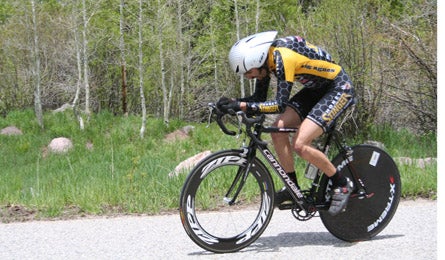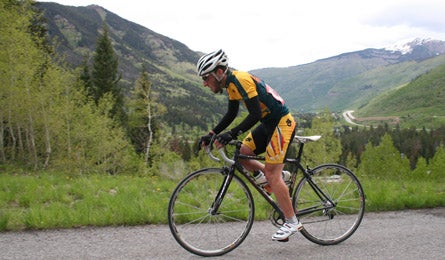Heading out the door? Read this article on the new Outside+ app available now on iOS devices for members! Download the app.



This past weekend, the Teva Mountain Games blew through Vail, Colorado, bringing a whirlwind of multi-sport madness in paddling, kayaking, mountain and road biking, climbing, bouldering, and even dock-dog jumping events. Rather than just cover the action, BACKPACKER decided to join in—specifically, for the GNC Ultimate Mountain Challenge, an individual or team event that covers four major races: paddling, trailrunning, mountain biking, and road biking.
Here, Assistant Map Editor Mark Harrison gives us the lowdown on the Fetzer Vineyards Hill Climb, a grueling road bike race that sends cyclists towards the clouds up 10,662-ft. Vail Pass.
Fetzer Vineyards Road Bike Hill Climb
There is a subtle difference between riding a bicycle up a mountain and racing a bicycle up a mountain. The former I do quite often; it usually involves rolling over to my favorite local café for coffee and a croissant before chatting leisurely with friends on a ride up to 9,000 feet (where we reward ourselves with homemade chocolate chip cookies before cruising back down to another cup of coffee).
The latter involves heaping amounts of lung-searing pain and is never any fun until it’s over. Every now and then I forget this difference and sign up for a race to remind myself. Enter the Fetzer Vineyards Vail Pass Hill Climb.
My race plan was pretty simple: don’t get passed. Not getting passed in a time trial doesn’t necessarily mean that you’re doing well–it just means that you don’t feel like you’re doing poorly. On a bicycle, perception is reality.
After successfully not wiping out on the starting ramp (an achievement in itself), I hit it hard on the frontage road leading up to the pass. Far ahead, I could just pick out a rider ahead of me; about half-way in, it became clear that I was going to pass him. This was a huge bump to my race plan/ego, so as the climbing grade ticked up around mile 6, I decided to burn a bit more fuel and catch my newfound nemesis. Crowds were cheering riders early in the climb, and I could feel a real adrenaline boost as I zeroed in on the rider ahead.
A super-aero competitor.
With about three miles to go, I passed him. I felt great, and then I realized that he only had one leg. And then I got passed by some other guy in a fully aero bike. And then another. At that point in the race, I was noticing a discomforting pounding in my chest and generally feeling like a schmuck for demonizing a courageous amputee cyclist. All the same, I dug deep to finish without imploding physically (and mentally). At the finish, I felt hollow and a bit queasy: a good sign that I hadn’t left too much in the tank (and that the post-race PBR was going to be sooooo good).
A mile or so into my descent back downhill, I slowed down as I came upon the one-legged cyclist still plugging away at the climb. I offered a word of encouragement, but he was lost in his own mid-race mind game, suffering but intensely focused on the objective at hand. Sometimes, I don’t get people who are so busy racing their bikes that they forget to enjoy riding them. And sometimes I forget that bike racing is just a damn good way to prove you’re still alive. That’s a perception I can get behind.
Total Course Time: 36:34:42
GPS Map of the Race Course
(Tune in tomorrow for reports on the rest of BACKPACKER’s events at Teva, plus video!)
—Mark Harrison